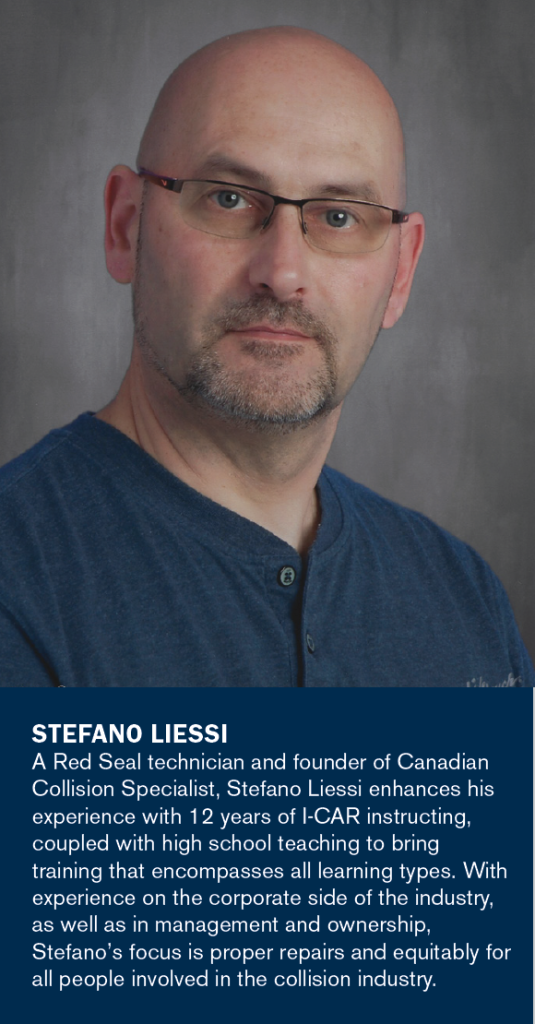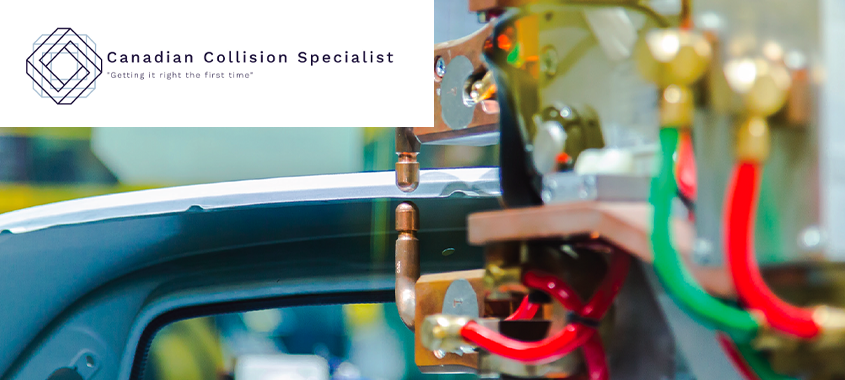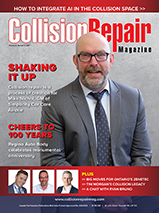THE SYNTHESIS OF OUR INDUSTRY
COMBINING TWO OR MORE DISTINCT ENTITIES—A.K.A., JUST WELD’ER UP
Column by Stefano Liessi
If I had $6.72 for every time I heard “my guy has been doing this for thirty years—this welding certification is a waste of time,” I would be independently wealthy.
There are a lot of managers and owners that have fallen behind on their quality control. To be fair, many don’t know what they don’t know. Saying it this way has a far better tact than ‘ignorance is bliss’.
Now I get it, after someone has spent the last few decades performing career tasks repeatedly, they should be good at it, right? Not necessarily. As with any form of learning, the source from which you begin sets forth the path you will most likely travel. Let me elaborate. I grew up in Port Credit, Ontario, a small area south of Mississauga and just outside of Toronto. Back in the early 80s I started my career in collision repair—during my high school days, just as the wheel was invented.
My introduction to welding was as follows; for full effect, read in Pauly from the Godfather’s accent. “Franco! Show Stefano how to weld ’dat patch with da MIG!”
“Sure thing, Tony! Okay, Stefano, you see ah da tape on dat there knob, you no touch that knob, or else I break your finger. Im’a set ’ya up real nice. See, you put da clamp on here, da striker, and put a squeeze on da trigger ’til ’ya hear the WHOOSH sound—that’s da gas—you hear da bacon, everything’s good.”
And there you have it, welding 101 from Franco. Sadly, this is not embellished. Now, if I had not taken the initiative to better advance myself from that point forward, I could very well still be performing the safety squint when welding. If you look at the demographics that currently make up our industry, do some mental math, you will find that more than one of my session participants likely had a Francotype teach them to weld too.
The modern-day vehicle has advanced dramatically since my session with Franco; it requires an effort on the part of the tech and the shop to upgrade and professionally develop. The level of intricacy and precision these vehicles are built with requires the equal amount of precision in the repair process.
Having said this, we are not welders by trade—we are technicians that utilize the art of welding in our repair process, however, we are not welding daily. We require knowledge regarding the substrates we are faced with, the methods of welding these substrates, and the equipment that is used today. One and done, set it and forget it are long gone in our world. If this is your thought process, you need to rethink your career path, perhaps a flower shop is in your future, or… some training.
So, who is attending the training? Technicians, you know, the ones that Franco taught. If someone has been referring to their education from the School of Franco over the years, you can see how doing something for decades may not make you good at it. Also, managers, estimators, and insurance folk alike should also be attending some of these hands-on development sessions, so they understand what is involved.
Each time I hold a session I find that everyone takes away something new. What amazes me to no end is how few technicians attend and how basically no estimators or insurance people attend. Here is something to think about: if I was to hand everyone who walked into a session the required coupons to complete the ten I-CAR welds for certification with one attempt at each, no one would be certified.
That scenario is no different than welding a vehicle without setting up your welder. As technicians, and administrative personnel in the field, you have a fiduciary duty to keep up with the Joneses on the skill side of things to perform repairs to someone’s vehicle. This involves training, developing, upgrading and practice. If you think Tiger Woods doesn’t practice, think again.
Therefore, we have welder set up time on our sheet—you are putting that on there, right? Regardless of how good you think the tech might be, they need to set up the welder, complete destructive tests, document and verify. The OEMs require you to do this, many outline the specs of these tests. It is NOT included in operations, and it is NOT negotiable. This needs to be done for aluminum, silicon bronze, squeeze type, steel, even rivet bond. This is a line item for each substrate.
I am astounded at what I see in shops. I see pieces of equipment that just hours before were being used to repair a vehicle that are almost unusable. How? I don’t know. Just look at the photos with the article, these are real scenarios. Today’s equipment is fantastic compared to what I used with Franco. Maintain it, it is costly and fragile, and it makes you money. Too many times I have heard techs say, “this welder is crap!” Yes, you are correct the welder is crap—if only said welder new how to use and maintain it. We may not do as much welding as we once did, which makes it even more imperative to keep up your skill set by attending training, practice proper estimating to include welder set up time, complete destructive tests, and practice those welds. You should as a technician try to put in an hour or two a week minimum, refresh yourself on each substrate and applicable machine. If you can, try to educate the administrative positions on the nuances of welding on todays vehicles. In my opinion, and you are entitled to my opinion, a little effort goes a long way. This will make you a better technician, a better shop, better working environment, and safer repairs with a clear conscience.






















